Introduction
Recently, research using bee products in traditional medicine and modern medicine has been progressing rapidly [1]. The main purpose of the various studies is not only to investigate the utility that continuously benefits health, but also to focus on the pharmacological properties of bee products [1,2]. These results lead to the development of various nutritional supplements and functional foods [1,3]. In recent years, the concept of functional food has expanded to define food as more capable of improving physiological or psychological health compared to conventional remedial and nutritional foods [4]. Hence, these effects contribute greatly to maintaining good health, well-being and reducing chronic diseases [2,5,6].
In general, propolis, honey and royal jelly are widely known as bee products that promote human health [1–7]. Among them, propolis is generally known as 'bee glue'. Propolis is a natural ingredient collected by Apis mellifera (belongs to Apidae family, genus Apis) from various plant sources [6,7]. The word “propolis” is derived from Greek “pro” and “polis” and means a substance that is for or in defense of the beehive [1,3]. The function of propolis was used for smoothing the inner surface of the beehive, for retaining the beehive’s internal temperature about 35°C, for preventing weathering, and for invasion by predators [1,3–5,7]. Simultaneously, propolis could harden the cell wall and contribute to an aseptic internal environment [1,5,6]. Propolis also possesses a pleasant smell, and becomes soft and sticky upon heating [1,7]. As far as it has been known, due to its antiseptic, antiinflammatory, antioxidant, antibacterial, antimycotic, antifungal, antiulcer, anticancer, and immunomodulatory properties, antidiabetic, antiprotozoan, antitumoral, dental action, and so on, propolis and its extracts have numerous applications in treating various diseases [1–8] (Fig. 1). Propolis is nontoxic, and the safe concentration for humans would be approximately 1.4 mg/kg and day or 70 mg/day [9].
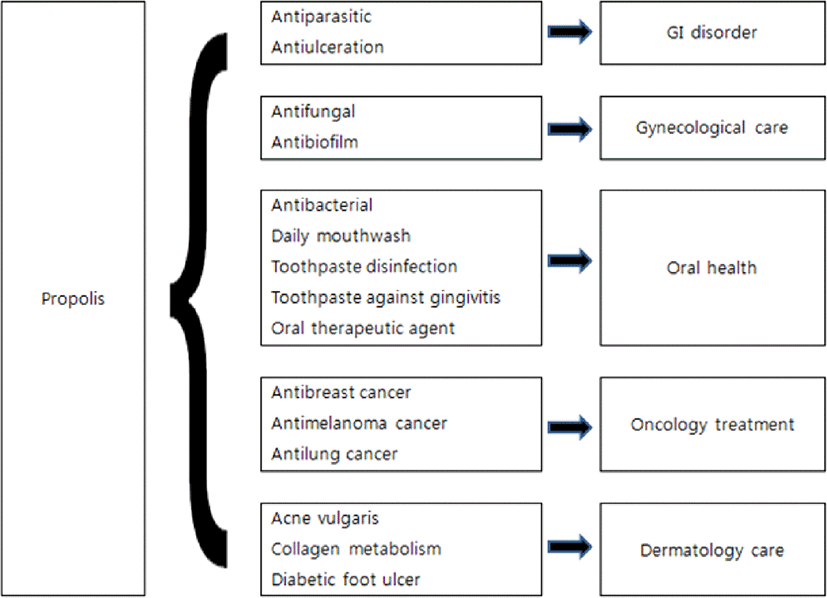
Propolis is composed mainly of resin (50%), wax (30%), essential oil (10%), pollen (5%), and other organic compounds (5%), and is the 3rd most important component of bee products [1,5]. The important organic compounds present in propolis are phenolic compounds (2 phenolic acids such as caffeic acid and cinnamic acid), esters, flavonoids (12 different flavonoids such as pinocembrin, acacetin, chrysin, rutin, luteolin, kaempherol, a1pigenin, myricetin, catechin, naringenin, galangin, and quercetin), terpenes, betasteroids, aromatic aldehydes, alcohols, and so on [1,4]. Also, propolis contains important vitamins (vitamin B1, B12, B6, C, and E) and useful minerals (magnesium, calcium, potassium, sodium, copper, zinc, manganese, and iron), and has a few enzymes (succinic dehydrogenase, glucose-6-phosphatase, adenosine triphosphatase, and acid phosphatase) [1,3–9].
Therefore, owing to propolis has many different advantages, propolis could be supplemented directly to several dairy products because it could improve the organoleptic testing and upgrade the health benefits of the human. Consequently, the purpose of this study is to obtain basic data for commercialization by investigating organoleptic testing by adding propolis of various concentrations to various dairy products such as market milk, yoghurt and Kefir.
Materials and Methods
Propolis used in this study was food grade and was manufactured in Brazil. The propolis product purchased was Extrato De Própolis Milagres 30 ML (Mel Milagres Ind. Brazil) and was consisted of bee collecting propolis in sucker of rosemary.
Market milk (Seoul Dairy Co-op, Korea), yoghurt and Kefir was supplemented with different concentrations (0%, 0.5%, 1.0%, 1.5%, and 2.0%) of Propolis, and then mixed thoroughly. Then, the market milk, yoghurt, and Kefir supplemented with propolis kept at 4°C until analyzed. Except for market milk, yoghurt and Kefir were manufactured according to the method of Lim et al. [10].
The pH of market milk, yoghurt and Kefir supplemented with propolis was measured using Thermo ScientificTM OrionTM Star A211 pH Benchtop Meter (Thermo Fisher Scientific Inc., Waltham, USA).
Market milk, yoghurt and Kefir supplemented with propolis were manufactured and kept in refrigerator until they were analyzed. All twenty evaluators participated in this study, and then estimated the organoleptic testing for each sample. In this study, the samples were randomly tested in disposable paper cups (50 mL) at 10°C. The organoleptic testing was consisted of 5 different categories such as taste, flavor, color, texture and overall acceptability, and also five-point hedonic value was rated 1 (extremely poor), 2 (poor), 3 (fair), 4 (good), and 5 (excellent).
All results in this study were taken from duplicate assays in two separate experiments, and were analyzed by the statistical software of GraphPad Prism 5 (GraphPad Softward Inc., USA). Also, all results were demonstrated as means±SD. Significant differences were estimated using Fisher’s least significant difference tests. Results with value “p< 0.05” was considered significant.
Results and Discussion
In this study, the pH of market milk was about 6.6 to 6.5, and the pH of yoghurt and Kefir dropped to 3.8 and 3.7, respectively (Table 1). The pH of propolis was about 4.98±0.06 (data not shown).
The level of pH of market milk, yoghurt and Kefir supplemented with different concentrations 0%, 0.5%, 1.0%, 1.5%, and 2.0%) of propolis demonstrated similar to that of market milk, yoghurt and Kefir without having the propolis (Table 1). Therefore, except market milk, the pH of yoghurt and Kefir did not represent any statistical significant difference between treated group and control group conducted in this study.
El-Deeb [11] reported that four different concentrations of propolis were supplemented to buffalo milk, but the pH was all equal at 6.77 to 6.80. The pH of the yoghurt sample was almost constant, although it was between 4.5 and 4.6 [11]. Hence, this showed a similar tendency to this experiment.
Fig. 2 demonstrated the summary of organoleptic testing of market milk estimated by twenty evaluators.
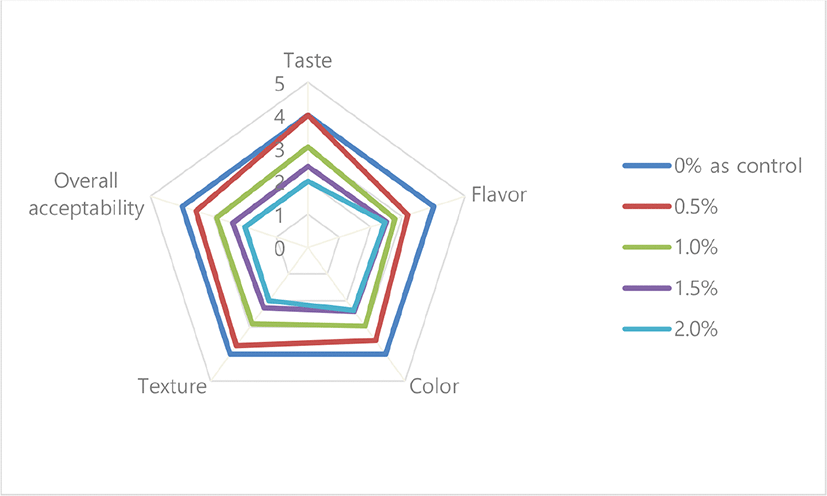
Market milk was supplemented with different concentrations 0%, 0.5%, 1.0%, 1.5%, and 2.0%) of propolis. The taste value of market milk supplemented with propolis was from 4.0 to 2.0, which were similar or lower than 4.0 of control group. The flavor value of market milk supplemented with propolis was from 3.18 to 2.45, which was lower than 4.0 of control group. The color value of market milk supplemented with propolis was from 3.49 to 2.36, which was lower than 4.0 of control group. The texture value of market milk supplemented with propolis was from 3.68 to 2.0, which was lower than 4.0 of control group. And the overall acceptability value of market milk supplemented with propolis was from 3.56 to 2.0, which was lower than 4.0 of control group.
According to statistical analysis on the organoleptic testing of market milk, there was a statistically significant difference in taste, flavor, color, texture and overall acceptability between treated group and control group (p<0.05). Furthermore, as the supplement of propolis increased, the category of taste, flavor, color, texture and overall acceptability tended to decrease.
Among the treated group, the market milk supplemented with 0.5% of propolis showed the best results compared with control group.
According to “Utilization of propolis extract as a natural preservative in raw milk" by El-Deeb [11], he strongly suggested that this method of preservation could be used to encourage the dairy farming by making possible the collection of more milk of high quality, which in turn is prerequisite for increased manufacture of high quality yoghurt [11].
Also, Thamnopoulos et al. [12] reported that the average acceptance score of the control milk, albeit higher that the average score of the propolis-containing milk, was not as high as expected from regular milk consumers (its average acceptance score was between the ‘like moderately’ and ‘like slightly’ categories) [12]. Especially, extended shelf life (ESL) milk with supplemented propolis received average consumer acceptability scores, indicating that there may be room, e.g. upon inclusion of additional (combinations of) flavor compounds, for the development of a propolis-flavored dairy drink with desirable organoleptic properties [12].
Fig. 3 demonstrated the summary of organoleptic testing of yoghurt estimated by twenty evaluators.
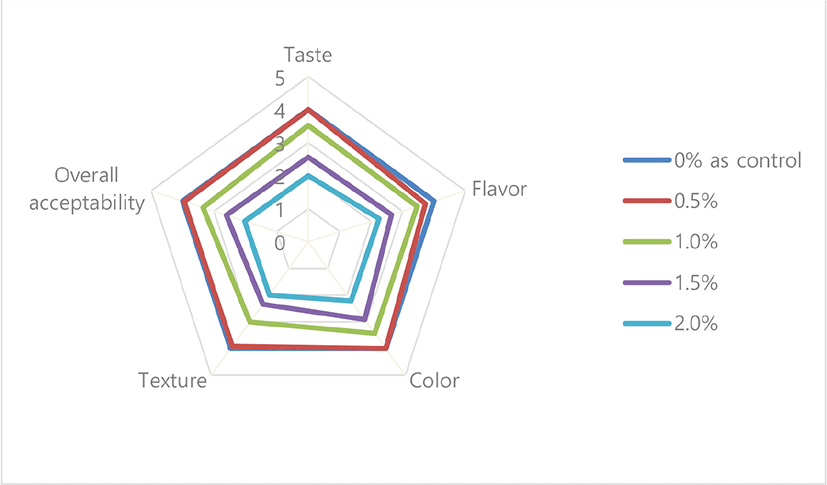
Yoghurt was supplemented with different concentrations 0%, 0.5%, 1.0%, 1.5%, and 2.0%) of propolis. The taste value of yoghurt supplemented with propolis was from 4.0 to 2.0, which were similar or lower than 4.0 of control group. The flavor value of yoghurt supplemented with propolis was from 3.73 to 2.26, which were lower than 4.0 of control group. The color value of yoghurt supplemented with propolis was from 4.0 to 2.21, which were lower than 4.0 of control group. The texture value of yoghurt supplemented with propolis was from 3.91 to 2.0, which were lower than 4.0 of control group. And the overall acceptability value of yoghurt supplemented with propolis was from 3.95 to 2.02, which were lower than 4.0 of control group.
According to statistical analysis on the organoleptic testing of yoghurt, there was a statistically significant difference in taste, flavor, color, texture and overall acceptability between treated group and control group (p<0.05). Furthermore, as the supplement of propolis increased, the category of taste, flavor, color, texture and overall acceptability tended to decrease.
Among the treated group, the yoghurt supplemented with 0.5% of propolis showed the best results compared with control group.
According to Santos et al. [13], the supplement of red propolis (0.05%) to replace the potassium sorbate did not change the pH, acidity, fatty acid profile, chemical composition, or shelf life. Also, yoghurt with red propolis showed higher antioxidant activity [13]. Therefore, for propolis-supplemented yoghurt to be recognized as an innovative product in the market, research on probiotics potential as well as functionality will have to be conducted.
Also El-Deeb [11] reported that sensory evaluation of food products is an important indicator of potential consumer preference. The prepared yoghurt showed that increasing levels of water extract of propolis negatively influenced the sensory scores of some properties of yoghurt [11]. Hence, this showed a similar tendency to this experiment.
Fig. 4 demonstrated the summary of organoleptic testing of Kefir estimated by twenty evaluators. Kefir was supplemented with different concentrations 0%, 0.5%, 1.0%, 1.5%, and 2.0%) of propolis. The taste value of Kefir supplemented with propolis was from 3.95 to 2.04, which were lower than 4.0 of control group. The flavor value of Kefir supplemented with propolis was from 3.82 to 2.47, which were lower than 4.0 of control group. The color value of Kefir supplemented with propolis was from 3.56 to 2.34, which were lower than 4.0 of control group. The texture value of Kefir supplemented with propolis was from 3.39 to 2.0, which were lower than 4.0 of control group. And the overall acceptability value of Kefir supplemented with propolis was from 3.68 to 2.14, which were lower than 4.0 of control group.
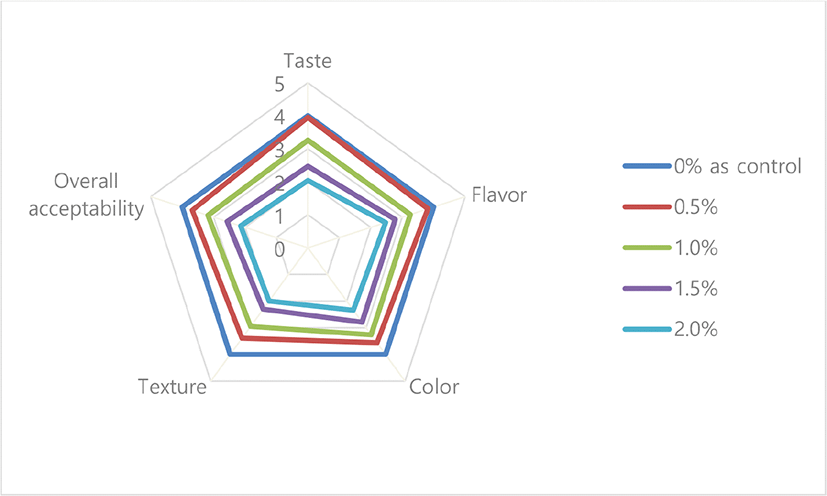
According to statistical analysis on the organoleptic testing of Kefir, there was a statistically significant difference in taste, flavor, color, texture and overall acceptability between treated group and control group (p<0.05). Furthermore, as the supplement of propolis increased, the category of taste, flavor, color, texture and overall acceptability tended to decrease.
Among the treated group, the Kefir supplemented with 0.5% of propolis showed the best results compared with control group.
Since there has been no research to add propolis to the Kefir so far, this study is believed to have very valuable and important significance as the first study to confirm the availability of the Kefir using propolis.
And, Fig. 5 demonstrated the changes of color in market milk, yoghurt, and Kefir supplemented with different concentrations 0%, 0.5%, 1.0%, 1.5%, and 2.0%) of propolis. In this study, market milk, yoghurt, and Kefir supplemented with different concentrations 0%, 0.5%, 1.0%, 1.5%, and 2.0%) of propolis were changed to light brown (Fig. 5). For this reason, it was thought that the scores of colors in market milk, yoghurt and kefir supplemented with propolis were all low in the organoleptic testing.
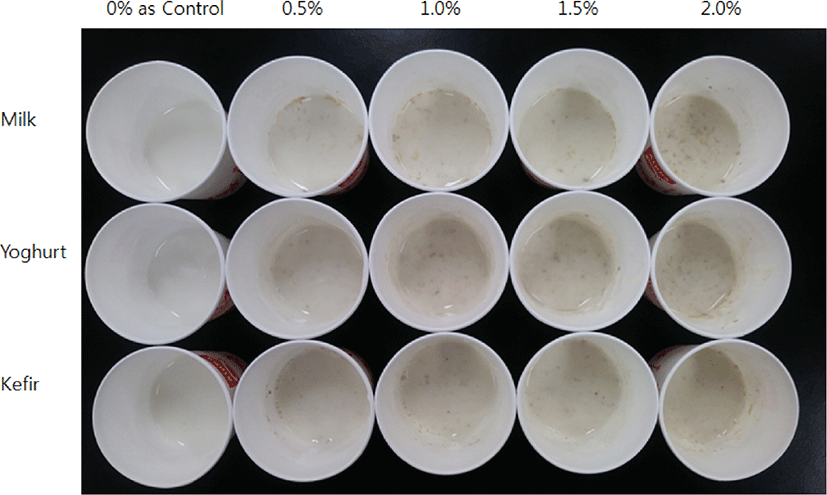
According to Kim et al. [14], as the supplement of propolis increased, preference decreased due to the propolis-specific flavor and flavor. Also Habryka et al. [2] reported that propolis supplemented to honey at an increasing concentration let to a significant increase in sharp, bitter and foreign taste, and presence of aftertaste. Similar to previous research results, this study demonstrated a tendency for preference to decrease as the amount of supplement increases (Figs. 2, 3, and 4).
Therefore, the following are the first considerations to be taken into account in order to solve this problem: If a dairy product is manufactured with a suitable supplement of propolis and a component that can offset the unique flavor and taste of propolis, it will show the possibility of manufacturing dairy products with various functional ingredients of propolis.
Next, in particular, in order to manufacture functional dairy products through propolis supplement, it is necessary to take a closer look at the bioactive compounds that propolis has. As is already widely known, propolis is highly rich in bioactive compounds [1–7] (Table 2).
Generally, naturally occurring polyphenols and vitamins as part of the food chain are classified as essential and non-essential compounds, and these are considered bioactive ingredients [1-7,15]. In particular, these compounds naturally exist in food and provide many benefits to health through ingestion [2,5–7,9,16,17]. Phenolic compounds are bioactive compounds, and phenols are generally explained as organic compounds with an aromatic ring that is chemically bonded to one or additional hydrogenated substituents in the presence of corresponding functional derivatives [1–7,15]. In propolis, phenolic compounds are commonly present as flavonoids, and various phenolic compounds could contribute to the functional properties of bee products, including their antioxidant, antimicrobial, antiviral, antiinflammatory, antifungal, wound healing, cardioprotective activities, and so on [1–7,11–19].
In conclusion, according to propolis has distinct efficacies with significant nutritional properties and functional values, propolis could be effective in improving the health benefits for human [20]. Further research is essential in the future to identify the important mechanisms associated with the pharmacological action of bee products and determine the appropriate amount that can be taken to obtain health benefits. Also, many further studies should be carried out to ensure that propolis is applied to the development of various bioactive dairy products.






